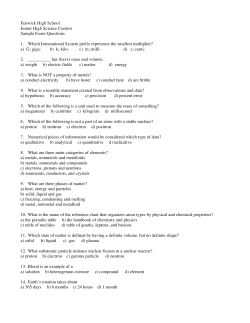
Document 395037
Student Name: Lab TA Name: A1101, Lab 3: Exploiting Galileo’s Observations Laboratory Worksheet Part 1: The Phases of Venus The first two pages on the graphs handout show the positions of the Earth, Sun, and Venus according to the Ptolemaic (geocentric) theory of the solar system and the Copernican (heliocentric) theory, at six times over the course of 1.6 years. In the geocentric diagram, the dashed circle marks the orbit of the Sun around the Earth, and the dotted circle marks the epicycle of Venus. According to Ptolemy, Venus moves on this epicycle, and the center of the epicycle itself revolves around the Earth and is always aligned with the position of the Sun. The large filled circle marks the position of the Earth, the star marks the position of the Sun, and the unfilled circle marks the position of Venus. In the heliocentric diagram, the dashed circle marks the orbit of the Earth around the Sun, and the solid circle marks the orbit of Venus around the Sun. The points are the same as before. For the geocentric case, sketch the expected phase of Venus at each of the six epochs shown in the diagram. Don’t worry about showing which “side” of the planet is bright -‐-‐ it will always be the one closer to the Sun – but figure out whether Venus as seen from Earth will be a crescent (like a crescent Moon), half illuminated (like a first-‐quarter or third-‐quarter moon), or more than half illuminated (like a gibbous moon). In the circles below, shade in the portion of Venus that will be dark, leaving the illuminated portion unshaded. Also indicate whether Venus will appear bigger than average or smaller than average at that epoch, by writing “big” or “small” above the circle. (a) (b) (c) (d) (e) (f) Now do the same thing for the heliocentric case. (a) (b) (c) (d) (e) ( f) What is the key difference in the predictions that these two theories of the solar system make for the phases of Venus? Which of the predictions is consistent with the observations of Venus shown in the planetarium? What conclusion could Galileo draw by observing the phases of Venus through a telescope? Why is diagram (f) shown at 19.2 months? What is special about this time? Part 2: The Moons of Jupiter The diagrams on the third page of the graph handout are inspired by drawings that Galileo made when he discovered the moons of Jupiter with a telescope. He observed four points of light very close to Jupiter and all in a line with Jupiter, and he noticed that the positions of these points of light changed from night to night, and even during the course of a night, but that they always stayed close to Jupiter. (We now know that Jupiter has other moons besides these four, but they are too faint to be seen with a telescope like Galileo’s.) In each diagram, the solid circle marks the position of Jupiter, and the asterisks mark the positions of the moons. The angular scale is marked in degrees – e.g., in the first observation, the third moon is separated from Jupiter by an angle of about 0.1 degrees. Each diagram shows an observation at a different time, separated by intervals of 0.5 days, as marked to the left or right. For your convenience (nature is usually not so kind), the first observation in the upper left shows a time when each moon is at its maximum angular separation from Jupiter. From inner to outer, the moons are Io, Europa, Ganymede, and Callisto. 1. What are the angular separations of the four moons from Jupiter, in degrees? Io: Europa: Ganymede: Callisto: 2. These observations correspond to the time when Jupiter is closest to the Earth, a distance of 6.3×108 km. Use the equation L = d × (θ / 57.3 degrees) to compute the radii of the moons’ orbits around Jupiter, in km. Io: Europa: Ganymede: Callisto: 3. From the diagram, determine the orbital periods of the four moons (i.e., how long they take to go around Jupiter), in days. Try to estimate the period to at least the nearest half day, and more accurately than that if you can. Io: Europa: Ganymede: Callisto: 4. Are your measurement uncertainties for the orbital radii and the orbital periods closer to 1%, 10%, 25%, or 50%? 5. You have conveniently been given observations separated by regular intervals of 0.5 days, which makes it easier to determine the orbital periods. Why would it have been impossible for Galileo to obtain a set of observations with a regular 0.5-‐day spacing? 6. Assume that the moons are orbiting Jupiter on circular orbits. (This assumption is very accurate.) Use the formula v = 2πr / P to compute the orbital speeds of the four moons, in km/s. Important: Remember to convert the period from days to seconds, using the fact that there are 60×60×24 = 86,400 seconds in a day. Io: Europa: Ganymede: Callisto: 7. The final page has the graph that you made in the last take home assignment, of orbital velocity of planets vs. their distance from the Sun. All the planets have been filled in for you. Using the numbers you have calculated above, add the moons of Jupiter to this graph, now using the separation from Jupiter instead of the distance from the Sun on the x-‐axis and using the orbital velocity around Jupiter instead of the orbital velocity around the Sun on the y-‐axis. Comment on your results in the space below: IMPORTANT: Before you leave, copy down your numbers for the orbital radius, orbital period, and orbital speed of the four moons. You will need them for your take home assignment.
© Copyright 2025














